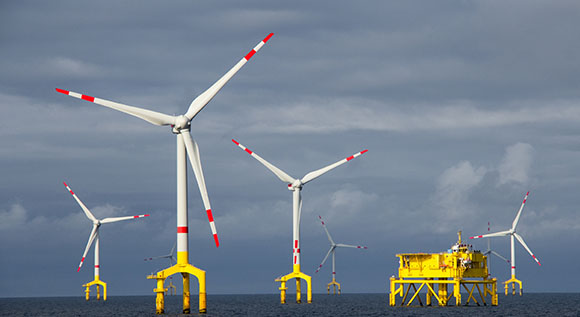Connecting giant turbines to the grid
The Fraunhofer Institute for Wind Energy Systems is currently developing the world's largest grid simulator. Teams of scientists can use the simulator to identify the best way to feed electricity from ever more powerful wind turbines into the grid.
 © AdobeStock / benoitgrasser
© AdobeStock / benoitgrasser
Weather conditions on the high seas are often difficult, particularly when there are strong winds. However, these conditions are perfect for giant wind turbines. That's when they can really show what they're made of. The turbines are feeding renewable electricity into the grid at an output of up to 20 megawatts. In light of the continued reorganisation of the grid and a rising share of renewables, ever more powerful offshore wind farms are being built. This helps generate more electricity, but also produces new challenges for grid connection. Because connecting giant turbines to the grid is not always an easy undertaking. The testbeds and grid simulators that are currently available to scientists are increasingly proving to be too small. They quickly reach the limit of their capacity and are therefore only of limited help when it comes to turbine optimisation.
A mobile grid simulator for field tests and analysis
It is against this backdrop that the Fraunhofer Institute for Wind Energy Systems has developed a mobile grid simulator as part of a research project to improve the compliance of new offshore installations with the grid. This simulator can be used to test and optimise even the largest of wind turbines. The mobile testing facility which allows for conducting on-site tests and analyses will have a capacity of 80 megavoltampere (MVA), making it the largest facility of this kind worldwide. Scientists can use the mobile testing facility for grid compliance checks to look at the electrical properties of offshore generation systems at different grid connection points. This will make it possible to simulate dynamic changes in frequency or the failure of a large wind turbine and therefore to develop realistic forecasts on the compliance of giant wind turbines with the grid – even those located far off land.
Surveying entire wind farms
The mobile testing facility for grid compliance checks is directly connected to the grid connection point at a particular test site. The 80 MVA grid simulator can test turbines with an output of up to 20 MW, allowing even to survey an entire wind farm or string. 'In addition to this, the facility helps us actively detect disruptions in grid operation,' Gesa Quistorf, project manager at Fraunhofer Institute for Wind Energy Systems (IWES), explains.
Mobile testing facility can be connected to hydrogen testbed
Professor Jan Wenske, deputy director of the Institute and technical director at Fraunhofer IWES adds that the new test bench could also be easily connected to existing test infrastructure and, additionally, to a hydrogen testbed which is currently being set up.
The launch of the grid simulator is scheduled for autumn 2022. The Federal Ministry for Economic Affairs and Energy is providing 12.7 million euros in funding for the project.
Further information
- Information on the mobile testing facility for grid compliance checks provided by Fraunhofer Institute for Wind Energy Systems (IWES)
- Information on the mobile testing facility for grid compliance checks provided on EnArgus – the Federal Ministry for Economic Affairs and Energy's energy research website (in German only)

